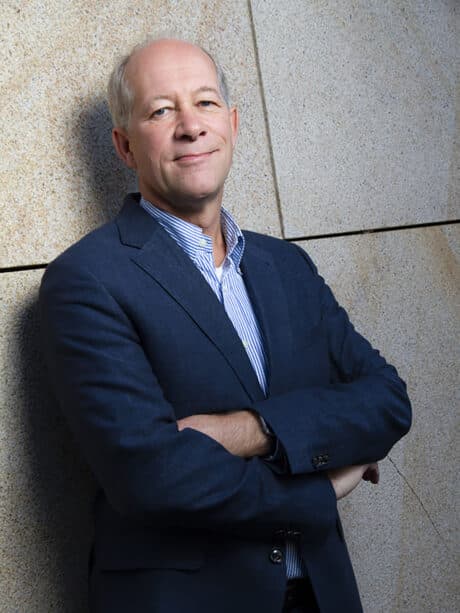

(Post)traumatic growth: Anti-fragility in an age of digital revolution
During the COVID-19 pandemic, it became very clear that anything and everything could be affected and many things that were taken for granted would have to be reinvented.

prof. dr. Paul Louis Iske
Open Innovation and Business VenturingExamples of the obviousness that was taken for granted are the way we do shopping, spend our vacations, maintain social contacts, meet each other, work together, enjoy sports and culture (or not) and how we organize and experience education and health care. Examples of the latter include online consultations, self-diagnosis (eye measurement) and online patient communities, such as ‚patients like me‘.
Paul Iske: „In almost all aspects of life, we have experienced the impact of innovation and because of the urgency, these changes have occurred at an incredible pace. If you look at the innovation process, you might conclude that the time to make the step from proof-of-concept to proof-of-business has shrunk tremendously. Usually this ‚last mile‘ is the biggest barrier to turning ideas into value. But now we have demonstrated to ourselves that it is indeed possible to effect change without falling victim to barriers that we have created for ourselves and result in ‚Organized Stupidity‘.
How did we do that and what can we learn from this period as we look at innovation? First of all, it is clear that many changes are possible because of digitalization. Online collaboration, meetings, doctor’s visits, socializing, classes, etc. Just a few years ago, all these alternatives would not have been possible. But technological innovation is not enough.
Who tells us that what was learned in the past can still be used as best practice in the present of the future?
If we only pay attention to technology and forget how important it is to address the human and organizational aspects of innovation, we once again stumble upon the familiar formula: NT+OO=DOO, or: New Technology applied in an Old Organization, results in an Expensive Old Organization! But because of the pressure, we had to accept that many things had to change, at least for the time being, in the way we work and live together, resulting in a massive ‚field lab‘, where we discovered things that worked and, of course, also things that didn’t work, or had to be there only as long as the crisis is active.
Learning from brilliant failures
This pressure cooker has rapidly increased our ability to innovate: we quickly implement and scale what works and we learn from the (brilliant) failures. Actually, this is a great example of „antifragility,“ which is a property of systems in which they increase in ability to thrive in response to stressors, shocks, volatility, noise, errors, attacks, or failures.
The concept was developed by Nassim Nicholas Taleb, also known for his famous book „The Black Swan. And indeed, COVID-19 can also be seen as a black swan: a major event that occurs without us being able to predict or control it, but with a major impact on our lives. The term antifragility comes at the end of the scale of fragile (breaks under impact), resilient (returns to its original state after impact), robust (is not affected at all) and antifragile (grows during and after impact). A good metaphor for antifragility is the hydra, the Greek mythological creature. When one head of the hydra is chopped off, two grow back.
Anti-fragile process
So perhaps a positive side effect of the current crisis is that we have discovered how to transform innovation into an antifragile process in two ways. First, the pressure has forced us to combine technological, mainly digital, innovation with social innovation. This has produced solutions that not only allow us to deal with the challenges of the current situation in the best possible way, but will also be of great value in the future. Some of these outcomes were already foreseen, but the change has been accelerated because of the urgency.
Second, innovation itself has become more antifragile. We have already talked about the „last mile,“ which prevents the rapid adoption of innovation, due to various barriers that we have primarily created ourselves, including rules and regulations, guidelines, funding models, personal resistance to change, organizational barriers, all of which contribute to our collective immune system to innovations.
Remember that best practices, which often result in rules and guidelines, are usually based on evidence obtained in the past. But who tells us that what was learned in the past can still be used as best practice in the present of the future? Moreover, we must accept that trial and error is sometimes the most effective way to find new solutions and that we should apply the lessons learned from failures as soon as possible. This fits very nicely with the mission of the Institute for Brilliant Failures, which seeks to create an environment where people accept failure as a gateway to learning and later success.
Hopefully, we will be able to use the insights gained during the crisis to grow stronger out of this difficult period, thanks to innovation. But we have seen that the innovation process itself can also be anti-fragile, by accepting failure as an integral part of development and by organized stupidity, reducing our self-inflicted pain!“

Source: ACADEMY Magazine 2021-2022 [Translated]

prof. dr. Paul Louis Iske
Open Innovation and Business VenturingPaul Iske is professor at the School of Business and Economics, University Maastricht, Netherlands, ...
Preisanfrage Profil ansehen